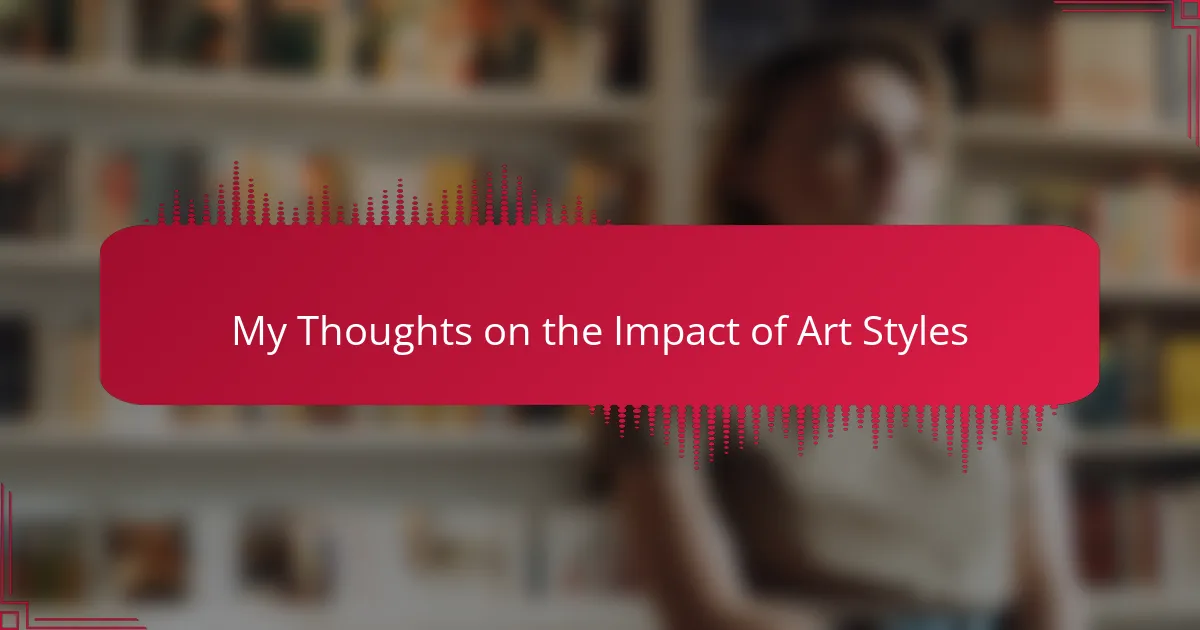Key takeaways
- Art styles convey emotions and influence storytelling in comics, enhancing reader engagement.
- Diverse styles, such as realism and cartoon, create distinct atmospheres and respond to different genres.
- Techniques like cross-hatching and color blending help artists develop unique visual expressions.
- Choosing the right art style is crucial for aligning with the intended emotional impact of the narrative.
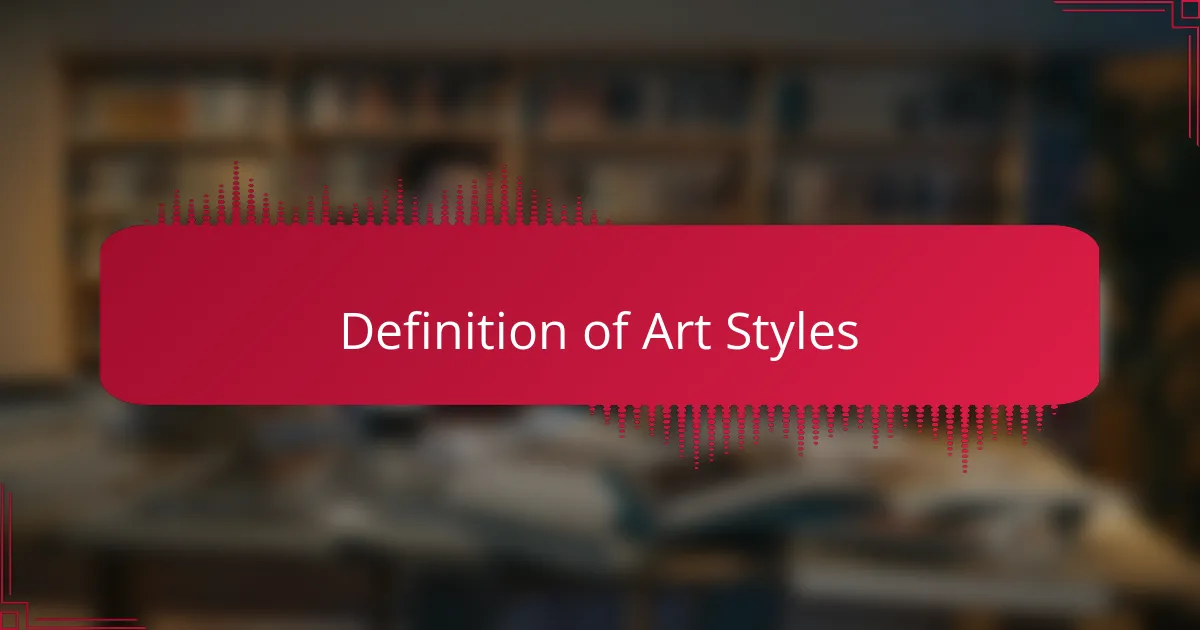
Definition of Art Styles
Art styles represent the unique methods and approaches artists use to convey their thoughts and emotions. They can range from realistic representations to abstract expressions, each carrying its own distinct voice. In my experience, understanding these styles has helped me appreciate the nuances in storytelling, especially within comic art.
As a comic book author, I often reflect on how different styles evoke varying emotional responses. For instance, the bold lines and vibrant colors of superhero comics can inspire excitement and heroism, while the subtle shading in indie comics can draw out a more introspective feel. This diversity in expression enriches the narrative landscape, allowing creators to connect with readers uniquely.
Here’s a simple comparison of some prominent art styles:
| Art Style | Description |
|---|---|
| Realism | Focuses on accurate, lifelike representations. |
| Expressionism | Emphasizes emotional experience over physical reality. |
| Abstract | Breaks away from traditional representation to explore shapes and colors. |
| Cartoon | Uses exaggerated features and simplified forms for humor or storytelling. |
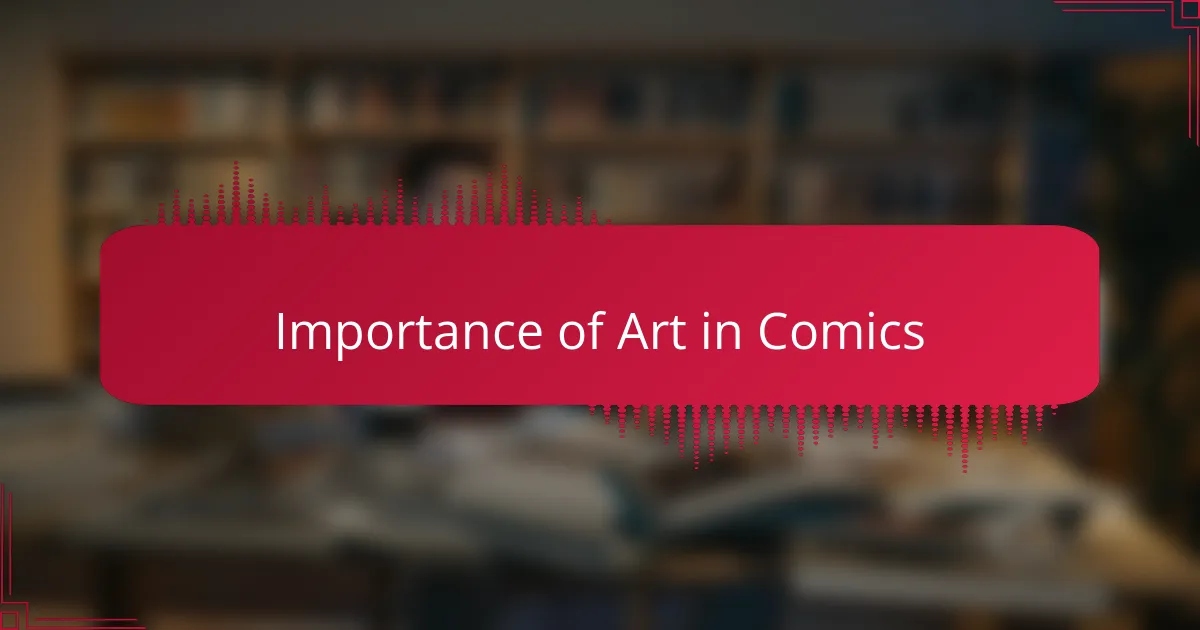
Importance of Art in Comics
Art plays a pivotal role in comics, acting as the visual language that conveys not just the story, but also the nuances of emotion. I remember picking up a comic as a child, captivated more by the intricate illustrations than the words themselves. Each stroke of the artist’s pen seemed to breathe life into the characters, allowing me to feel their joy, pain, and struggles even before I read the dialogue.
Furthermore, the choice of art style can significantly impact a reader’s experience, creating varying atmospheres that resonate differently depending on the narrative. For example, a gritty, dark style might enhance a superhero tale set in a dystopian future, while playful, vibrant illustrations could elevate a light-hearted adventure. The interplay between art and story is what makes comics a unique art form, engaging readers on multiple levels.
- Art style sets the tone and mood of the narrative.
- Visuals can evoke immediate emotional responses from the audience.
- Distinct styles can help differentiate genres and subgenres within comics.
- The relationship between text and art creates a richer storytelling experience.
- Great art can elevate even a simple story, making it memorable and impactful.
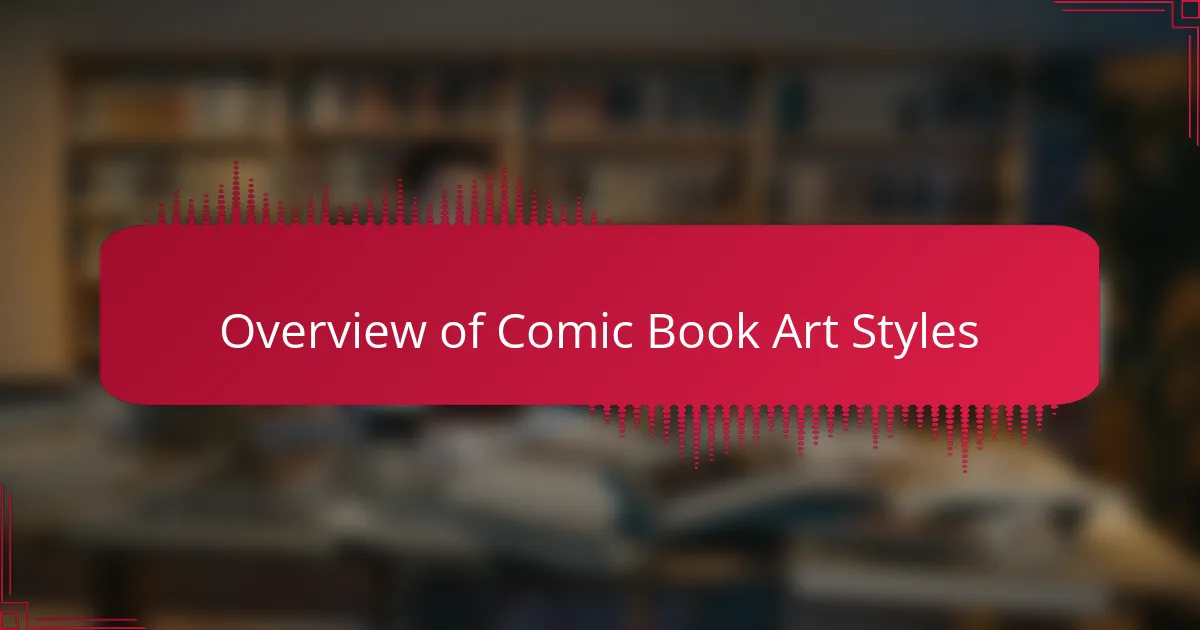
Overview of Comic Book Art Styles
When I think about comic book art styles, I see them as the heartbeat of storytelling. Each style resonates with the narrative, whether it’s the bold lines and vibrant colors typical of superhero comics or the softer, more whimsical aesthetics found in indie works. Personally, I’ve always been drawn to the intricate details of manga art; the way emotions are conveyed through sharp contrasts and dramatic angles always leaves a lasting impact on me.
The beauty of comic book art styles also lies in their diversity. They can evoke different emotions and atmospheres, making a single story more dynamic. For instance, the gritty realism of noir comics can enhance tension, while the playful, cartoonish style in humor comics can light up a reader’s mood. These choices influence how we connect with the characters and narratives, shaping our overall experience.
Here’s a succinct comparison table that highlights some popular comic book art styles:
| Art Style | Description |
|---|---|
| Superhero | Bold lines, bright colors, emphasizes action and heroics. |
| Manga | Detailed artwork, emotional expressions, often black and white. |
| Noir | Dark palettes, heavy shadows, adds tension and drama. |
| Cartoon | Exaggerated features, humorous, lighthearted approach. |

Techniques for Developing Unique Styles
Developing a unique art style is a journey of exploration and experimentation. I remember when I first started drawing comics; I was heavily influenced by my favorite artists. It wasn’t until I began to experiment with various techniques, like cross-hatching and color blending, that I discovered my own voice. I encourage every artist to try out different mediums and approaches until they find what resonates with them.
One technique I found particularly transformative is studying nature and incorporating its forms into my work. For example, observing how light interacts with different objects can help create depth in your illustrations. Another practice is to take inspiration from various cultures, as this can lead to intriguing combinations that make your style stand out.
Here’s a comparison table outlining some techniques for developing unique styles:
| Technique | Description |
|---|---|
| Cross-Hatching | A shading technique using parallel lines to create texture and depth. |
| Color Blending | Mixing colors to achieve depth and a more dynamic palette. |
| Influence of Nature | Using natural light and forms for inspiration to enhance realism. |
| Cultural Inspiration | Incorporating elements from various cultures to create a unique visual language. |
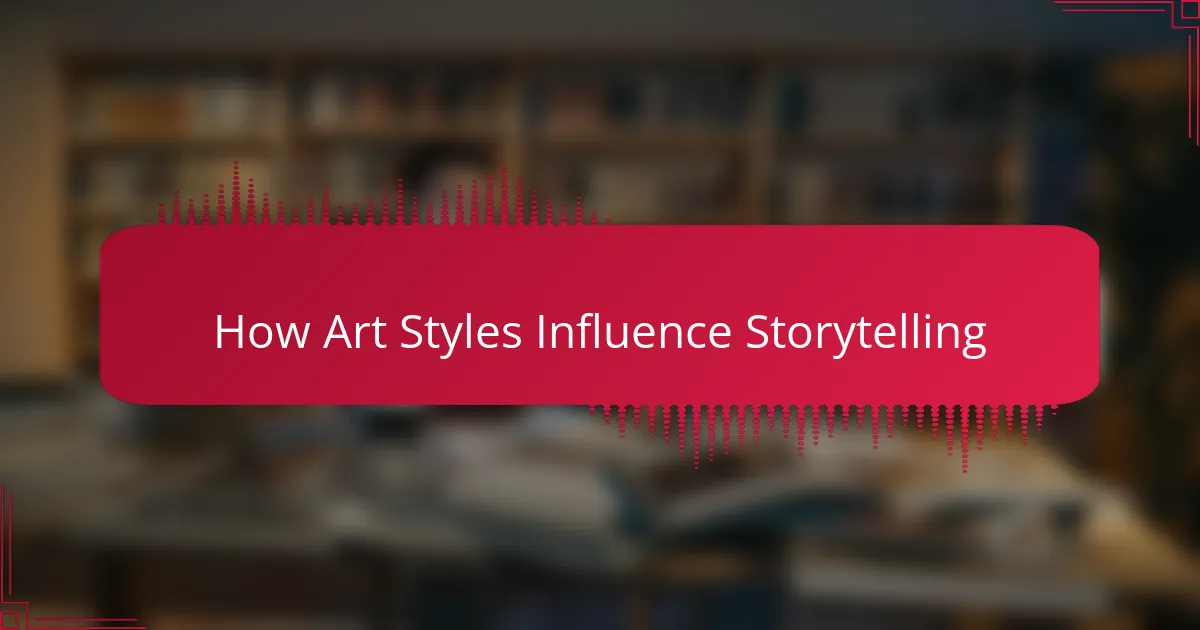
How Art Styles Influence Storytelling
Art styles play a crucial role in shaping storytelling in comics. For instance, a whimsical style can add a sense of lightheartedness to the narrative, inviting readers to experience a playful world. Conversely, a darker, more realistic art style can evoke deep emotional responses, amplifying the tension in a story about tragedy or conflict.
In my own experience, when I experimented with a more exaggerated art style for a comedic story, I found that it not only captured the humor but also helped readers feel the characters’ quirks more vividly. It was fascinating to see how the visuals directed the emotional undertones of the plot. Similarly, using detailed line work and shadows in more serious themes often left readers reflecting long after they turned the last page.
Here’s a comparison of how different art styles can impact storytelling:
| Art Style | Influence on Storytelling |
|---|---|
| Cartoonish | Creates a playful, light-hearted tone; emphasizes humor and whimsy. |
| Realistic | Enhances emotional depth; often used in serious or dramatic narratives. |
| Abstract | Encourages interpretation; can convey complex emotions and themes. |
| Grunge | Imparts a raw, gritty feel; often suits stories of hardship or conflict. |
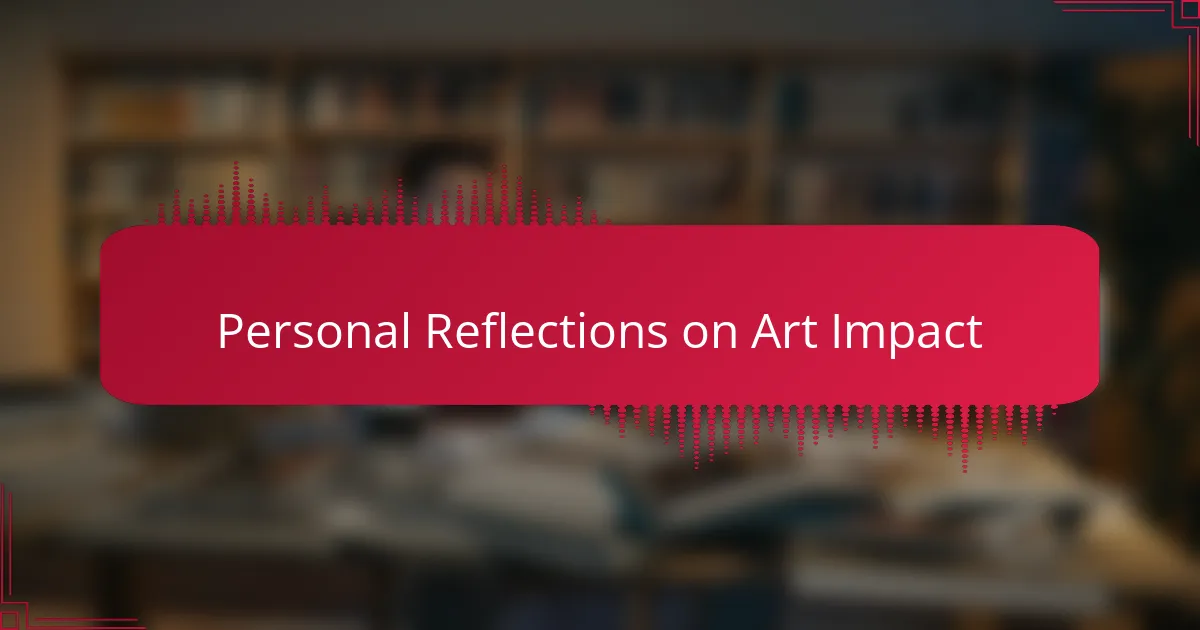
Personal Reflections on Art Impact
Art styles have a profound impact on how we perceive and engage with stories in comics. I think back to the first time I encountered a comic rendered in a minimalist style—it struck me how fewer lines could convey such deep emotions. It made me wonder, could simplicity sometimes speak louder than intricate detail? My experience suggests that art can be a powerful communicator, bridging the gap between the creator’s intention and the reader’s interpretation.
When I reflect on the impact of art, I often recall a comic I illustrated recently with a vintage noir style. The heavy shadows and moody tones shaded the narrative with an intensity that left readers on edge. They told me they could almost feel the damp streets of the city through the artwork. It’s these moments that remind me how the visual elements are essential threads in weaving a compelling narrative.
I’ve also noticed that art styles can influence not only individual stories but also entire genres within comics. For instance, the whimsical flair of children’s comics creates a world where everything feels possible and magical. This insight has led me to think about how important it is for authors to choose an art style that aligns with the emotions they wish to evoke. When I select colors and line styles, I’m not just thinking about aesthetics; I’m thinking about how to resonate with the reader’s heart.
